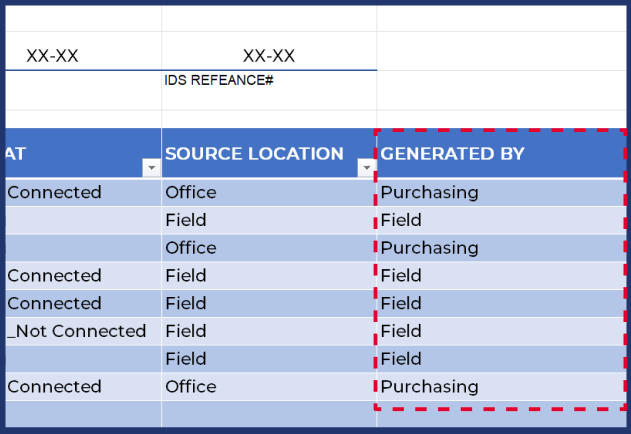Generated By
General
This field has a drop down for the parameters listed below. These represent commonly used parameter labels for data discovery but can be added to on the List Reference tab of the IDS.
Generated By
 This field is intended to capture the tool e.g., software or hardware, that generated the data not the actual source of the information. These tools are often referred to as publishing tools.
This field is intended to capture the tool e.g., software or hardware, that generated the data not the actual source of the information. These tools are often referred to as publishing tools.
Understanding the tool that was used to generate the data will allow us to quickly build a list of the tools that are necessary to perform a process, or what tools an individual needs to properly report critical data. It is important to separate the tool that is gathering the information from other tools that may be involved or that work with the data. To help clarify it let's look at an example.
Consider a time card that is filled out on iPad, in the field and emailed to the office. The “Generated By” might be excel, or a PDF form but it will not be the iPad or email. A distinction is made here between a generation tool, (excel or Bluebeam), the platform (IOS or iPad), and delivery tool (E-mail). Making this distinction can be somewhat difficult, so to help with clarity we can look at the file type or extension. The file extension is the last three letters after the period on a file, e.g., .doc, .pdf, .xls, etc. We will look at these closer as we’re filling out file type in a later part of this document. For now, looking at these extensions will tell us what program that file can be used in. This will typically be the tool we want to capture for “Generated By”. The reason for the distinction, is that tools such as e-mail or an iPad work with thousands of file types but do not generate or create those types without specific tools aligned to either the platform or attached as an extension of the software.
Because of the huge number of tools that generate data this is a user defined field, however standardizing on tools within your organization will help you maintain good digital hygiene and minimize the amount of training needed to produce the critical data desired. When filling out the IDS, previous tools will be listed and should be reviewed prior to entering a new tool in the field.
Understanding Good Stewardship
 Analog data is continuous, so it has an infinite range of values, while digital data is discrete, broken down into binary code (ones and zeros) for easy processing by computers. This means that some level of detail may not come through when transitioning too digital, so understanding the level of detail required is important when digitizing any analog information. This becomes visually apparent when turning images into digital information. Standard document digitization changes images from continuous lines and colors into individual points close together (resolution) and can appear grainy with magnification. This same loss of detail occurs in music at some level which is why people often prefer vinyl records to early CD's.
Analog data is continuous, so it has an infinite range of values, while digital data is discrete, broken down into binary code (ones and zeros) for easy processing by computers. This means that some level of detail may not come through when transitioning too digital, so understanding the level of detail required is important when digitizing any analog information. This becomes visually apparent when turning images into digital information. Standard document digitization changes images from continuous lines and colors into individual points close together (resolution) and can appear grainy with magnification. This same loss of detail occurs in music at some level which is why people often prefer vinyl records to early CD's.

